Of Belacan and Curry Puffs: A Taste of Singapore’s Past
Bonny Tan pores through the rich archives of Malayan newspapers and shows how disparate communities have come together to create a food culture that is truly emblematic of Singapore’s multicultural character.
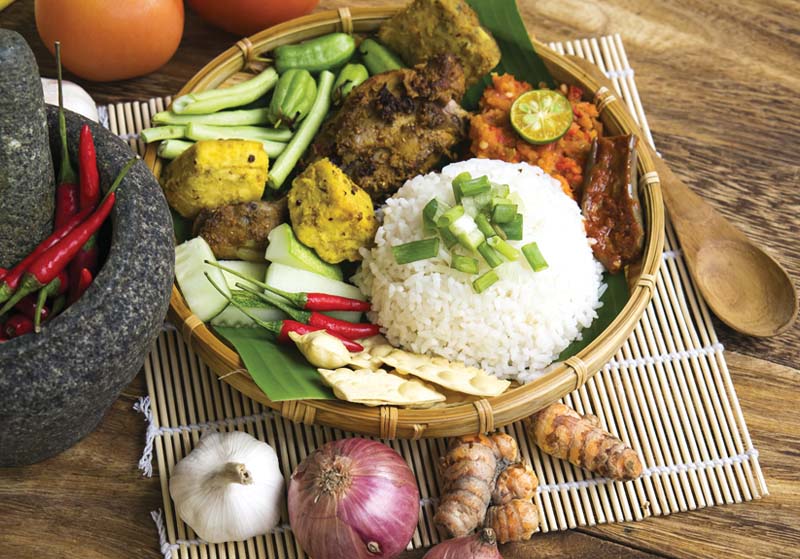 Belacan is used extensively in Malayan cooking and gives it its distinctive taste.
Belacan is used extensively in Malayan cooking and gives it its distinctive taste.Research into Singapore’s food heritage often neglects the unusually rich minefield of data found in newspapers. NewspaperSG, the National Library’s digital archive of local newspapers dating from 1831, provides easy access to a fascinating wealth of information found in otherwise banal resources such as news articles and columns, recipes, restaurant reviews, and even advertisements.
The history of belacan, a local condiment, and curry puff,1 a popular snack, is traced in this article, pieced together from reports taken from digitised English newspapers in Malaya during the interwar period. These newspaper reports unveil the faces and flavours behind these local foods, their evolution through racial adaptations and their colloqualisation into place names and language.
Food Reporting During Colonial Times
World War I saw a spike in marriage rates in Europe and a large number of women entering the workforce, a trend echoed in the expatriate community in Malaya.2 As more expatriate women, both married as well as working singles, settled in Malaya after World War I,3 the local culinary scene and, subsequently, newspapers began reflecting the interests and concerns of this new audience.
Where previously, articles on cooking and food in the newspapers mainly referenced the cook employed in the home, by the mid-1930s, regular columns in the English dailies that targeted women and their newfound spending power had started appearing. Thus, The Straits Times published “The World of Women”4 column in January 1935, which evolved into the “Women’s Supplement”,5 while The Malayan Saturday Post ran a page entitled “A Woman’s Viewpoint”.
Interestingly, these articles featured fancy dinner parties, fashionable wear, strange sights in Malaya (from the European point of view, of course, of mainly local folks) but precious little on tasting local food and much less cooking it.
Encouraged by the conveniences of tinned food, refrigeration and fresh imports of meat and milk from Australia, the European community remained averse to cooking and eating local foods and flavours. News of the war in the West and its threat to the East saw a “grow more food” campaign, with several newspaper articles urging readers to grow and cook local vegetables,6 especially since the country had experienced dire food shortages during the interwar years. In August 1941, a broadcast talk entitled “Wartime Cook” was announced in the papers.7 After the fall of Singapore to the Japanese, the internment of Europeans was possibly the first time many Caucasians in Singapore began regularly eating rice and local ingredients,8 albeit not by choice.
The Malaya Tribune, a newspaper started in 1914 and targeting Asiatic readers, is credited with training local journalists, particularly in the 1930s.9 Eventually, these journalists went on to anchor the increasingly localised English newspapers in post-war Singapore. Local food columnists of the 1970s and 1980s such as Violet Oon, Lee Geok Boi and Sylvia Toh Paik Choo, reinforced the romanticisation of the iconic dishes of the 1950s and 1960s as they reminisced over the food they grew up with. Thus, the flavours of local cuisine began to take centre stage in food columns, with greater attention paid to its ingredients, preparation methods and consumption.
Flavours of Singapore
Belacan
Belacan is a condiment peculiar to the region with parallels in Myanmar (ngape), Indonesia (terasi, petis), the Philippines (bagoong), Thailand (kapi) and China (hae ko). Though strongly rooted in Southeast Asian culture, it is believed that the colonial Portuguese brought this pungent concoction to the region since dishes associated with a fermented seafood paste similar to belacan are found in places such as Goa and Macau where the Portuguese had been colonial masters for centuries.
The pungent belacan is manufactured through a crude process of fermenting tiny shrimp (grago or gerago) or krill, which includes salting, grinding (or foot-pounding before the advent of modern machinery) and sunning for several weeks, during which time the paste turns from a rosy pink to a deep shade of brown. The resulting cake of belacan is thinly sliced, toasted and then used to flavour meats, enhance curries, gravies and stews, and add a distinctive edge to sambal belacan, a spicy hand pounded condiment of belacan and fresh chillies brightened with lime juice. Many Malayan dishes rely on belacan to give it a unique Malayan flavour.
Belacan may have been indispensable for flavouring local food, but newspapers reveal that its overpowering olfactory presence, particularly in the 19th and early 20th centuries when Singapore had several belacan factories by the coast, offended the European population’s sense of smell. Belacan naturally became one of the few local food items written about in English newspapers, almost always because of its potent stink. An 1891 letter from “one with a sensitive nose” complaining about the nefarious effusions from a government licensed belacan factory along Tanjong Rhu, a coastal health getaway in colonial Singapore, described it thus: “The odour of blachang [sic] is peculiarly Asiatic, there is nothing in Europe to contend with it; it is ghastly, penetrating and abominable… if a tired city man happens to land at ‘Sandy Point’ to reach Tanjong Katong… then a whiff comes from the blachang factory that makes his hair stand on end, and fills him with criminal impulses”.10
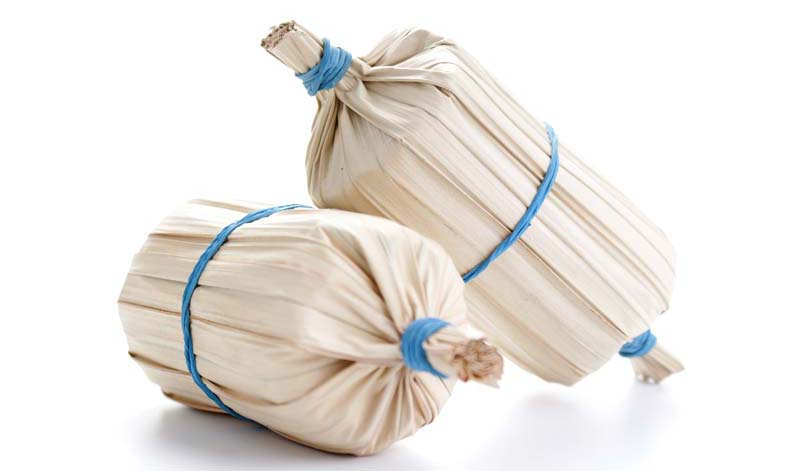 Belacan in traditional packing.
Belacan in traditional packing. Belacan is thought to have been brought to Southeast Asia by the Portuguese.
Belacan is thought to have been brought to Southeast Asia by the Portuguese.However, newspaper reports, one as early as 1874,11 indicate that a few Europeans had a connoisseur’s appreciation for this foul-smelling ingredient as suggested by its nickname – the Malayan caviar12 or the Malaccan cheese, where its best versions came from.13 Interest in its flavours was reflected by an enquiry on how to make “blachan toast” in the English newspapers in 190114 and by the 1920s a greater discernment of its varied use in dishes was seen: “The balachan [sic] is decidedly a delicious compound. It can be cooked in various ways, fried simply and mixed with chillies, onions, garlic, and aromatic herbs of different kinds with prawns, fish, crabs… The ‘curry’ so well known in this part of the world has got to be flavoured with this condiment without which it will lose much of its palatable taste. Balacan is equal to or superior (to some tastes) to any European caviarre [sic]… but the taste for it must be acquired. The smell is decidedly objectionable.”15
Belacan is not only a key ingredient in Chinese, Malay and Eurasian dishes;16 newspapers reveal that entire communities were named after it or its raw ingredient, grago (or gerago). The Portuguese-Eurasian fishermen of Malacca who dragged nets to catch these tiny shrimp were themselves referred to as grago,17 which otherwise was a term of contempt used to describe the impoverished segments of the Eurasian community.18 At the same time belacan-making was so strongly associated with the Malays that they themselves were often referred to as belacan.19 A popular local saying among Malays at the time was: “Kalau tidak makan belacan, bukanlah orang Melayu” (If you don’t eat belacan, you are not Malay).20 The Peranakans too favoured the use of belacan in their cooking due to the Malay influence in their dishes. The fact that newspaper articles of the time associated different communities with this condiment is an indication how its production and consumption cut across racial lines even in colonial times. The condiment was so much a part of the social fabric that the communists who were holed up in Malayan jungles at the time even purportedly used it to make bombs.21
Curry Puff
The curry puff is often considered a local invention unique to Singapore and Malaysia though variants of it can be found in Thailand and the Philippines. The origins of the curry puff are clouded, but it is often attributed to European colonial influence, its pastry having similarities to the Cornish pie or the Portuguese empanada. The curry puff’s spicy meat and potato filling point to an obvious Indian connection.
A scan through digitised British newspapers of the early 20th century show that the curry puff and its indubitable partner, the sausage roll, were often served in cafes in England, Australia and India.22 The filling was often cold curry leftovers which were then “encased in a flakey pastry”,23 sealed into a triangular shape,24 then baked. One of the earliest references to the curry puff was an article in a local newspaper about the snack being served to underprivileged children during charitable Christmas parties in the 1930s.25 At these annual parties, the curry puff was packed along with other colonial staples, such as an apple, a tin of milk, chocolates and cake, and given as gifts during a day out with dodgem car riding at the Great World Amusement Park. The curry puff was not merely poor man’s fare as evidenced by the Special Dinner and Dance supper menu served at the Adelphi Hotel in 1932, which included the puff alongside dishes such as mayonnaise de saumone, roast chicken and roquefort cheese.26
The famous Polar Cafe is believed to have created the first baked curry puff in Singapore. The recipe for the spicy chicken curry filling supposedly came from an Indian merchant while the flaky and buttery puff pastry was a British influence.27 The resulting Polar curry puff was a product of the ingenious marriage between colonial and colonised taste buds. Founded in the mid-1920s by Hong Konger Chan Hinky, who arrived in Singapore with little money, the Western-style café along High Street sold baked goods and ice cream, which soon became popular with the parliamentarians, lawyers and the rich who worked and lived around the Supreme Court and Parliament House.
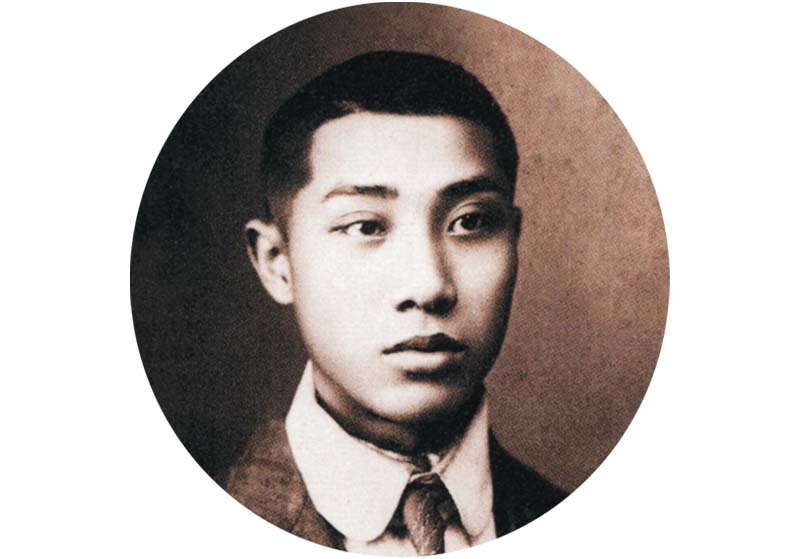 Founder of Polar Cafe, Chan Hinky, arrived in Singapore in the early 20th century, with little to his name. Courtesy of Polar Puffs & Cakes Pte Ltd.
Founder of Polar Cafe, Chan Hinky, arrived in Singapore in the early 20th century, with little to his name. Courtesy of Polar Puffs & Cakes Pte Ltd.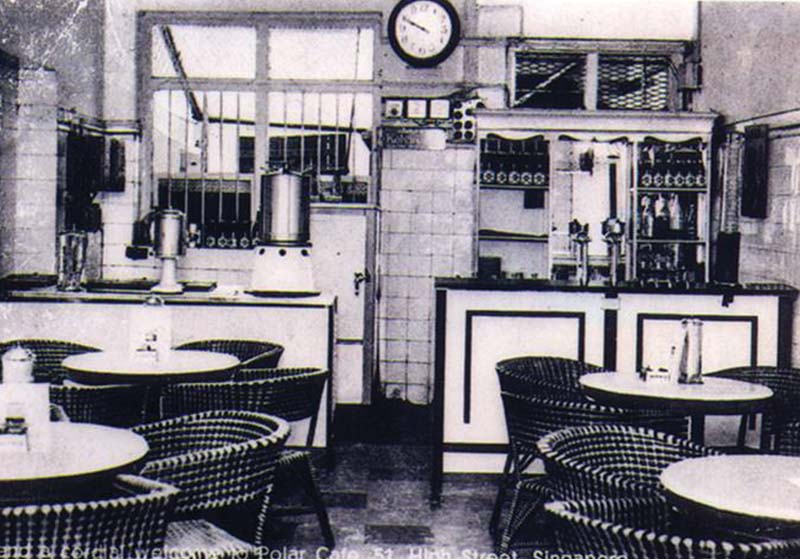 The original Polar Cafe was located along High Street in the 1920s and popular with those who frequented the area. Courtesy of Polar Puffs & Cakes Pte Ltd.
The original Polar Cafe was located along High Street in the 1920s and popular with those who frequented the area. Courtesy of Polar Puffs & Cakes Pte Ltd.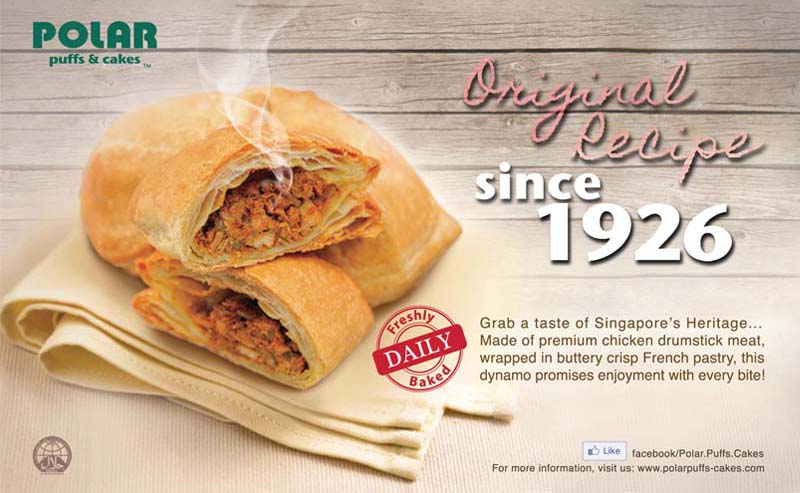 Established in the 1920s, the flaky polar puff can now be found island-wide in convenience stores and supermarkets. Courtesy of Polar Puffs & Cakes Pte Ltd.
Established in the 1920s, the flaky polar puff can now be found island-wide in convenience stores and supermarkets. Courtesy of Polar Puffs & Cakes Pte Ltd.By the 1980s, frozen versions of this baked curry puff were being mass produced for sale, and included exotic variations such as the black pepper chicken puff. These Western curry puffs were shaped and served as pies, with hot meat and potato filling encased in flaky puff pastry and eaten in a restaurant setting. Today, these trademark snacks known as “Polar puffs” come with a variety of fillings and are sold everywhere in Singapore, including petrol stations, convenience stores and supermarkets.
Like the samosa in India which can be either baked or fried, there are two versions of local curry puffs – a baked version made of puff pastry and offered at Western-style cafes and a fried version encased in shortcrust pastry and sold as streetside fare, especially popular among the Muslim community. Straits Times writer Derek Drabble’s 1950 caricature of an Indian Muslim thamby (meaning “little brother” in Tamil), Adam Ghat, shows him serving curry puffs and other streetside delights such as “gluey kaya jam”, “pisang mas” (fried banana fritters) and “Bengali roti buns” (bread rolls) along Finlayson Green to office workers of various races, including Indian, Malay and Chinese.28 This Malay version of the curry puff – a deep-fried crescent-shaped dough crimped and stuffed with a spicy sardine or potato filling and served with a sweet chilli dipping sauce – is today known as epok-epok.
Old Chang Kee probably has redefined and popularised what is today considered a quintessential traditional Singaporean food. Transforming the Malay epok-epok into a popular fast-food snack,29 this Chinese version is chockfull of mildly curried potato and chicken mixture stuffed with one-half of a boiled egg. The pastry is a rich buttery base that is rolled out with an empty beer bottle, cut out into circles and then stuffed with the filling – a secret mix of diced chicken stewed in coconut milk, spices and curry powder. Sealed into a crescent-shape and crimped at the edges, the puff is then deep-fried until golden brown.30 It was Old Chang Kee’s move into modern franchising and distribution regionally in the 1990s, then worldwide soon after, that made this buttery shortcrust pastry into the trademark Singapore curry puff we know today.
Linda Neo’s article31 details how in the 1980s, Old Chang Kee’s founder, Chang Swang Boo, had assistants bring his prepared curry puffs from Albert Street around the corner to MacKenzie Lane where they were deep-fried on the spot for waiting customers. These curry puffs were thereafter associated with the Rex cinema along MacKenzie Lane, thus earning it its early nickname – Rex curry puff. With two other curry puff competitors coming on board, MacKenzie Lane soon came to be called Kali Pup lane – a play on the Chinese mispronunciation of the words curry puff.32
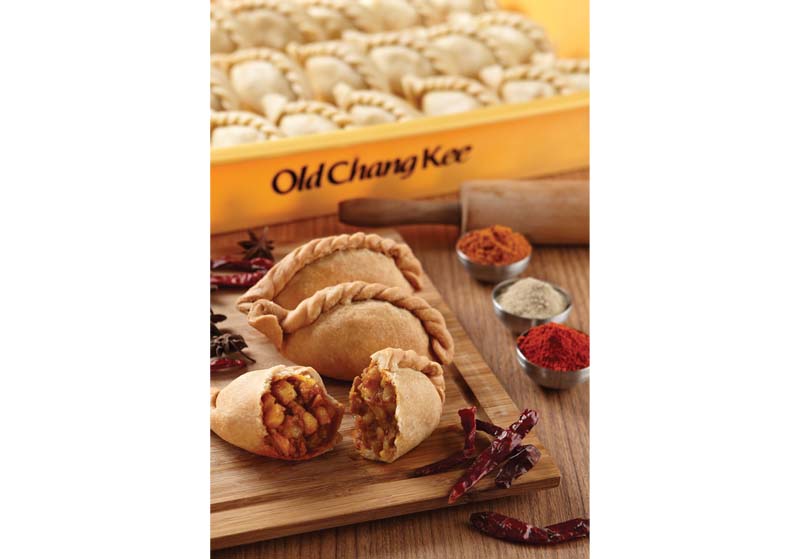 Established in the 1980s, Old Chang Kee is now a household name and is best known for its curry puffs. Courtesy of Old Chang Kee Ltd.
Established in the 1980s, Old Chang Kee is now a household name and is best known for its curry puffs. Courtesy of Old Chang Kee Ltd.Kali pup also became ingrained in the local psyche when Elvis Presley’s signature pompadour hairdo of the 1960s became known as the kali pup hairstyle,33 a reference to the turned-up (and heavily greased) fringe that invariably reminded locals of their favourite local snack.
In exploring iconic local dishes, newspaper articles help paint a multi-dimensional picture of local dishes and their consumption over time. In the case of belacan, these articles reveal how local flavours influenced dishes across racial boundaries, signaling the blurring of lines between communities. Similarly, the humble curry puff is truly an East meets West success story, drawing influences from both India and Britain before being adopted and then adapted by cooks in Singapore and Malaysia. Food is a canvas upon which cultures and communities are able to create new narratives, drawing together and integrating different peoples and races, making Singapore a true (and tasty) melting pot in the process.
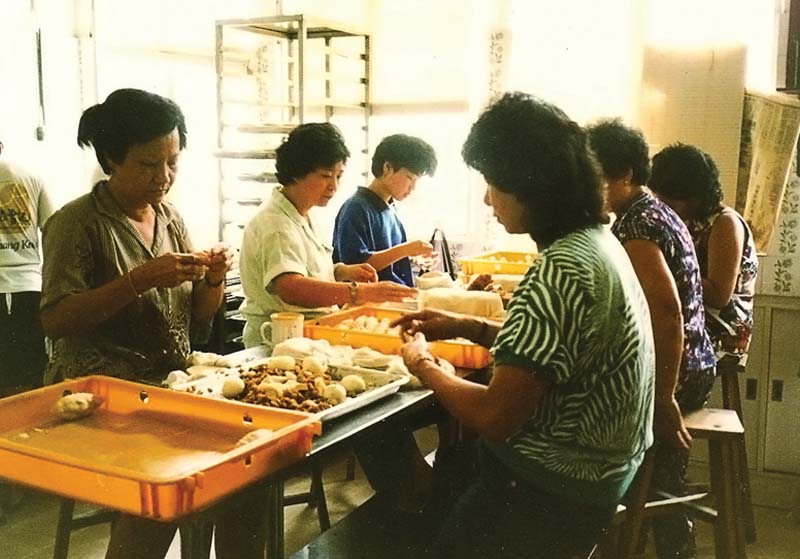 Workers filling and sealing curry puffs to be baked and sold. Image from currypuff.com. All rights reserved.
Workers filling and sealing curry puffs to be baked and sold. Image from currypuff.com. All rights reserved.
STEPPING ON IT
In the traditional method of making belacan, the semi-dried and salted shrimp are placed into holes dug into the ground. Thereafter, women would trample on these dried shrimp for at least an hour in large wooden tubs – not unlike what Italian women would do to grapes in order to produce wine in the old days – before the drying process began again. English author Isabella Bird described in her 1883 book, The Golden Chersonese and the Way Thither, how belacan was made with bare feet “trampling a mass of putrefying prawns and shrimps into a paste”. In the modern era, this process of mashing is done with machinery. Similarly, belacan is no longer pressed into tampin, conical containers woven out of mengkuang leaves (a variety of pine), like in times past and then sold in the market. Nowadays, belacan is pressed into thin rectangular blocks or circular discs prior to being wrapped with paper or plastic and shipped out to supermarkets.

Bonny Tan is a Senior Librarian with the National Library of Singapore. Her passion for Singapore food has increased with her move to Vietnam, where she currently telecommutes from.
REFERENCES
Books
Brazil, D. (1991). Street smart Singapore. Singapore: Times Books International. (Call no.: RSING 959.57 BRA)
Butcher, J.G. (1979). The British in Malaya, 1880–1941: The social history of a European community in colonial South-East Asia. Kuala Lumpur: Oxford University Press. (Call no.: RSING 301.4512105951033 BUT)
Cheung, S.C.H., & Tan, C.B. (Eds.). (2007). Food and foodways in Asia: Resource, tradition and cooking. London: Routledge. (Call no.: RSEA 394.12095 FOO)
Leong-Salobir, C. (2011). Food culture in colonial Asia: A taste of empire. New York: Routledge. (Call no.: RSING 394.12095 LEO)
Peet, G.L. (2011). Within Changi’s walls: A record of civilian internment in World War II. Singapore: Marshall Cavendish Editions. (Call no.: RSING 940.53175957092 PEE)
Mazelan bin Anuar., Law, C., & Soh, W.Y. (2012, August). Challenges of digitizing vernacular newspapers & preliminary study of user behaviour on newspaperSG’s multilingual UI [Paper presented at IFLA Pre-Conference in Mikkeli, Finland]. Retrieved from IFLA website.
Tan, C.B. (Ed.). (2011). Chinese food and foodways in Southeast Asia and beyond. Singapore: NUS Press. (Call no.: RSEA 394.12089951059 CHI)
Turnbull, C.M. (1995). Dateline Singapore: 150 years of the Straits Times. Singapore: Times Editions for Singapore Press Holdings. (Call no.: RSING 079.5957 TUR)
Wu, D.Y.H., & Tan, C.B. (Eds.). (2001). Changing Chinese foodways in Asia. Hong Kong: The Chinese United Nation Press. (Call no.: RSING 641.300951 CHA)
Newspaper articles
300 children go gay. (1960, December 20). The Singapore Free Press, p. 8. Retrieved from NewspaperSG.
A Kelantan Malay on Asiatics. (1950, August 3). The Straits Times, p. 6. Retrieved from NewspaperSG.
Abdul Ghani Hamid. (2003, July 17). Belacan dulu, belacan hari ini. Berita Harian, p. 9. Retrieved from newspaperSG.
Abu Bakar Mardiana. (1988, March 1). Bahasa: Focus now on pronunciation. The Straits Times, p. 5. Retrieved from NewspaperSG.
Balachan. (1925, August 29). The Singapore Free Press and Mercantile Advertiser, p. 11. Retrieved from NewspaperSG.
Blachan toast. (1901, July 24). The Straits Times, p. 3. Retrieved from NewspaperSG.
Boey, S. (1971, June 30). Red camp where blachan bombs were made. The Straits Times, p. 19. Retrieved from NewspaperSG.
Broadcast talks on wartime cooking. (1941, August 15). The Straits Times, p. 12. Retrieved from NewspaperSG.
Chan, M. (1982, December 26). Stroll down Kali Pup lane. The Straits Times, p. 16. Retrieved from NewspaperSG.
Chan, M. (1987, November 22). An old recipe adds fillip to satay dish. The Straits Times, p. 4. Retrieved from NewspaperSG.
Changkol for victory. (1940, August 10). The Singapore Free Press and Mercantile Advertiser, p. 4. Retrieved from NewspaperSG.
Chia, K.S. (1952, February 28). The shrimpers of Tanjong Bungah. The Straits Times, p. 10. Retrieved from NewspaperSG.
Distressful Malacca. (1910, May 12). The Singapore Free Press and Mercantile Advertiser, p. 5. Retrieved from NewspaperSG.
Drabble, D. (1950, February 23). A Tamby takes it easy – with a curry puff. The Straits Times, p. 12. Retrieved from NewspaperSG.
Free Press news feature. (1940, June 4). The Singapore Free Press and Mercantile Advertiser, p. 3. Retrieved from NewspaperSG.
House and home. (1914, May 28). Hull Daily Mail, England. Retrieved from the Australian Trove.
Learn to be a cook of many dishes. (1939, August 24). The Straits Times, p. 6. Retrieved from NewspaperSG.
Lim, R. (1997, December 7). The Ah Beng in all of us. The Straits Times, p. 2. Retrieved from NewspaperSG.
Malacca. (1874, August 1). The Straits Times, p. 2. Retrieved from NewspaperSG.
Memories of old Singapore disguised as Chinese, a European attended secret society meetings. (1947, May 17). The Straits Times, p. 8. Retrieved from NewspaperSG.
Ms Violet Oon says. (2006, April 17). The Straits Times, p. 4. Retrieved from NewspaperSG.
Neo, L. (1980, July 12). Curry puffs from old man Chang in Albert Street. The Straits Times, p. 7. Retrieved from NewspaperSG.
On the margin. (1951, August 30). The Straits Times, p. 6. Retrieved from NewspaperSG.
Page 1 Advertisements Column 1: Adelphi Hotel. (1932, January 22). The Singapore Free Press, p. 1. Retrieved from NewspaperSG.
Page 13 Advertisements Column 1: Season Confectionary. (1969, June 1). The Straits Times, p. 13. Retrieved from NewspaperSG.
Shukor Rahman. (1973, July 9). Blachan: Where it all began. The Straits Times, p. 14. Retrieved from NewspaperSG.
Singapore Girl Guides. (1921, February 17). The Straits Times, p. 8. Retrieved from NewspaperSG.
Spent 50 yrs selling satay. (1947, June 22). The Straits Times, p. 3. Retrieved from NewspaperSG.
Straits Times goes Pinyin. (1979, March 20). The Straits Times, p. 15. Retrieved from NewspaperSG.
T.F. Hwang takes you down memory lane. (1974, March 9). The Straits Times, p. 12. Retrieved from NewspaperSG.
The belachan trade. (1924, September 27). The Singapore Free Press and Mercantile Advertiser, p. 12, Retrieved from NewspaperSG.
The smells of Singapore. (1891, July 21). Straits Times Weekly, p. 12. Retrieved from NewspaperSG.
The women’s page. (1917, June 8). The Land, pp. 10–11. Retrieved from The Australian Trove.
Vegetables and “Grow More Food” campaign. (1940, February 12). The Singapore Free Press and Mercantile Advertiser, p. 5. Retrieved from NewspaperSG.
Websites
The Australian Trove.
The British Newspaper Archive.
NOTES
-
These items have been selected because of several reasons – their pervasive reference in newspapers spanning the period studied and their localised flavours. Although there are many other dishes such as Hainanese chicken rice, laksa, mee siam etc, their articulation especially in the English newspapers of the interwar period is not extensive. ↩
-
Butcher, J.G. (1979). The British in Malaya, 1880–1941: The social history of a European community in colonial South-East Asia (p. 142). Kuala Lumpur: Oxford University Press. (Call no.: RSING 301.4512105951033 BUT) ↩
-
This column seemed to have begun on 10 January 1935 with a half-page but soon expanded to a full page. ↩
-
This continued the weekly Thursday column which was expanded into a four-page supplement first released on 16 January 1936. ↩
-
Granted the main targets for the “grow more food” campaigns were local farmers, but there are articles that appeal to the Malayan to venture growing his own food such as Vegetables and “Grow More Food” campaign. (1940, February 12). The Singapore Free Press and Mercantile Advertiser, p. 5; Changkol for victory. (1940, August 10). The Singapore Free Press and Mercantile Advertiser, p. 4. Retrieved from NewspaperSG. ↩
-
Broadcast talks on wartime cooking. (1941, August 15). The Straits Times, p. 12. Retrieved from NewspaperSG. ↩
-
Peet, G.L. (2011). Within Changi’s walls: A record of civilian internment in World War II (pp. 67–68). Singapore: Marshall Cavendish Editions. (Call no.: RSING 940.53175957092 PEE) ↩
-
Turnbull, C.M. (1995). Dateline Singapore: 150 years of the Straits Times (p. 102). Singapore: Times Editions for Singapore Press Holdings. (Call no.: RSING 079.5957 TUR) ↩
-
The smells of Singapore. (1891, July 21). Straits Times Weekly, p. 12. Retrieved from NewspaperSG. ↩
-
Malacca. (1874, August 1). The Straits Times, p. 2. Retrieved from NewspaperSG. ↩
-
Shukor Rahman. (1973, July 9). Blachan: Where it all began. The Straits Times, p. 14. Retrieved from NewspaperSG. ↩
-
The Straits Times, 9 Jul 1973, p. 3. ↩
-
Blachan toast. (1901, July 24). The Straits Times, p. 3. Retrieved from NewspaperSG. ↩
-
Balachan. (1925, August 29). The Singapore Free Press and Mercantile Advertiser, p. 11. Retrieved from NewspaperSG. ↩
-
The belachan trade. (1924, September 27). The Singapore Free Press and Mercantile Advertiser, p. 12, Retrieved from NewspaperSG. ↩
-
Distressful Malacca. (1910, May 12). The Singapore Free Press and Mercantile Advertiser, p. 5. Retrieved from NewspaperSG. ↩
-
Twentieth century newspaper articles still refer to the more economically established local Eurasians as ‘grago’ though in a less contemptuous fashion. ↩
-
A Kelantan Malay on Asiatics. (1950, August 3). The Straits Times, p. 6. Retrieved from NewspaperSG. ↩
-
Abdul Ghani Hamid. (2003, July 17). Belacan dulu, belacan hari ini. Berita Harian, p. 9. Retrieved from newspaperSG. ↩
-
Boey, S. (1971, June 30). Red camp where blachan bombs were made. The Straits Times, p. 19. Retrieved from NewspaperSG. ↩
-
These include searches in the British Newspaper Archive as well as the Australian Trove. ↩
-
House and home. (1914, May 28). Hull Daily Mail, England. Retrieved from the Australian Trove. ↩
-
Particularly The women’s page. (1917, June 8). The Land, pp. 10–11. Retrieved from The Australian Trove. ↩
-
1,200 children entertained. (1936, 24 December). The Straits Budget, p. 14; 1,500 children enjoy Rotary Christmas Party. (1939, 16 December). The Straits Times, p. 11. Retrieved from NewspaperSG. [Note: Even into the 1960s, curry puffs seemed to be the norm for Christmas delights in children’s parties. See 300 children go gay. (1960, December 20). The Singapore Free Press, p. 8. Retrieved from NewspaperSG.] ↩
-
Page 1 Advertisements Column 1: Adelphi Hotel. (1932, January 22). The Singapore Free Press, p. 1. Retrieved from NewspaperSG. ↩
-
Brazil, D. (1991). Street smart Singapore (pp. 14–15). Singapore: Times Books International. (Call no.: RSING 959.57 BRA) ↩
-
Drabble, D. (1950, February 23). A Tamby takes it easy – with a curry puff. The Straits Times, p. 12. Retrieved from NewspaperSG. ↩
-
Ms Violet Oon says. (2006, April 17). The Straits Times, p. 4. Retrieved from NewspaperSG. ↩
-
Neo, L. (1980, July 12). Curry puffs from old man Chang in Albert Street. The Straits Times, p. 7. Retrieved from NewspaperSG. ↩
-
The Straits Times, 12 Jul 1980, p. 4. ↩
-
Chan, M. (1982, December 26). Stroll down Kali Pup lane. The Straits Times, p. 16. Retrieved from NewspaperSG. ↩
-
Lim, R. (1997, December 7). The Ah Beng in all of us. The Straits Times, p. 2. Retrieved from NewspaperSG. ↩

